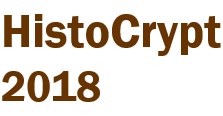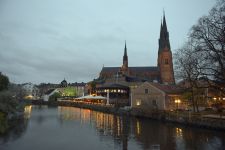

Home Important dates Organization Proceedings Program Invited speakers Accepted papers Workshops Instructions for presenters Instructions for authors Call for papers Venue and Social Events Accommodation Local information About Uppsala Travel to Uppsala Sponsorship Past events
International Conference on Historical Cryptology
Invited speakers
Craig Bauer, Professor of mathematics at York College of Pennsylvania, editor in chief of the journal Cryptologia.
Katherine Ellison, Professor of English Literature, associate chair, Dept. of English, Illinois State University.
David Naccache and Rémi Géraud, Professors at the École normale supérieure, Paris, France.
CANCELLED: Shlomo Shpiro, Professor of Security and Intelligence, Bar-Ilan University, Israel.
Ephraim Lapid, Bar-Ilan University and IDC Herzliya, Israel.
Special Session on Arne Beurling:
Kjell-Ove Widman, professor emeritus of Mathematics, will give a talk about Arne Beurling and his work.
George Lasry, University of Kassel, Germany.
 Craig Bauer
Craig Bauer
Craig P. Bauer is professor of mathematics at York College of Pennsylvania and the editor-in-chief of Cryptologia.
He was the 2011-2012 Scholar-in-Residence at the National Security Agency (NSA) Center for Cryptologic History and
is the author of two books: Secret History: The Story of Cryptology and Unsolved!: The History and Mystery of the
World's Greatest Ciphers from Ancient Egypt to Online Secret Societies. His television appearances include
the mini-series The Hunt for the Zodiac Killer and two episodes of Codes and Conspiracies.
Title
Updates on the World’s Greatest Unsolved Ciphers
Abstract
Craig’s book, Unsolved! The History and Mystery of the World's Greatest Ciphers from Ancient Egypt to Online Secret Societies,
saw print a little over a year ago. Many updates can now be made. The talk includes highlights from the book, progress
that has been made on several ciphers contained therein, and images of more historic unsolved ciphers, as challenges
for conference attendees.
 Katherine Ellison
Katherine Ellison
PhD, is co-editor of A Material History of Medieval and Early Modern Ciphers: Cryptography and the History of Literacy (2017)
and author of A Cultural History of Early Modern British Cryptography Manuals (2016) and Fatal News: Reading and Information
Overload in Early Eighteenth-Century Literature (2006). Professor of English at Illinois State University, she has published
widely on cryptology, media history, and literacy in Games and War, Early Modern Trauma, Literature Compass, the Journal for
Early Modern Cultural Studies, the Journal of the Northern Renaissance, Book History, Eighteenth-Century Fiction, Educational
Research, Academic Exchange Quarterly, Maternal Pedagogies, and Sex and Death in Eighteenth-Century Literature. She is
beginning a new collection with Medievalist Dr. Susan Kim on John Matthews Manly and Edith Rickert and a monograph on
Fop Intelligence, an investigation of cryptology and gender identity.
Title
Cryptology and the Fantasy of Reading
Abstract
This presentation will explore the central role of cryptology in the history of reading, when literacy became a goal of
the masses rather than a special skill reserved only for the educated elite. Beginning in the seventeenth century,
instructional cryptography manuals established the foundational terms and methodologies of literacy training. Cryptologers
including John Wilkins, Gustavus Selenus, Gasparis Schotti, Noah Bridges, and John Falconer sought not only to educate the
public in ciphering and deciphering but to establish multimodal habits of everyday literacy; they had a vision of the
future of citizen literacy that resisted the dominance of alphabetic reading and insisted that literacy must encompass
alphabets as well as mathematics, algorithms, scientific symbols, musical notation, visual images, and digital technologies
(and they did use the term “digital,” as in requiring the use of the digits). Cryptology also provided the framework for
teaching audiences how to see the ways in which the habits of printing, page layout, and the physical materiality of books
and paper all make meaning in relation to the symbols on the page. Though their methods did not heavily influence
eighteenth- and nineteenth-century educational theorists, the revival of cryptologic curiosity during World War I,
in particular, brought the seventeenth-century methods to the attention of figures like John Matthews Manly,
Edith Rickert, the Friedmans, and others. Riverbank Laboratory even began publishing primers for teaching kindergarteners
how to read – by teaching them the bilateral cipher of Francis Bacon.
David Naccache and Rémi Géraud
Professors at the École normale supérieure, Paris, France.
Title
A French code from the late 19th century
Abstract
The Franco-Prussian war (1870–1871) was the first major European conflict during which extensive telegraph use
enabled fast communication across large distances. Field officers would therefore have to learn how to use secret
codes. But training officers also raises the probability that defectors would reveal these codes to the enemy.
Practically all known secret codes at the time could be broken if the enemy knew
how they worked.
Under Kerckhoffs’ impulsion, the French military thus developed new codes, meant to resist even if the adversary knows the encoding and decoding algorithms, but simple enough to be explained and taught to military personnel.
Many of these codes were lost to history. One of the designs however, due to Major H. D. Josse, has been recovered and this article describes the features, history, and role of this particular construction. Josse’s code was considered for field deployment and underwent some experimental tests in the late 1800s, the result of which were condensed in a short handwritten report. During World War II, German forces got hold of documents describing Josse’s work, and brought them to Berlin to be analysed. A few years later these documents moved to Russia, where they have resided since.
 Ephraim Lapid, Bar-Ilan University and IDC Herzliya Israel.
Ephraim Lapid, Bar-Ilan University and IDC Herzliya Israel.
Brigadier General (Res.) Dr. Ephraim Lapid is a lecturer at Bar-Ilan University and IDC Herzliya Israel.
He served as a Senior Intelligence officer in the Israel Defense Forces (I.D.F) and was the I.D.F. Spokesperson
and Instructor in the Israeli National Defense College. After retiring from the Israeli Military, he was a senior
official in the Jewish Agency.
Title
The Israeli Enigma
Abstract
During the early years of the State of Israel, most of its intelligence collection and early warning was based on
Humint, i.e. intelligence agents and operatives, which required rapid clandestine and secure communication. Sigint
technologies of the First and Second World Wars were used already by the Jewish armed underground organizations
before the establishment of the state. Smart, sensitive Sigint systems for receiving and acquiring signals with
rapid reaction time were developed over time, enabling high-quality access to targets. Today Israel's Sigint
units work around the clock and adapt themselves to changes in communications and signals.
From its early days, the Israeli military has developed a Signals Corp to provide effective and secure communication to the needs of the defense establishment. From the start, there was good cooperation between the functions of cyphering and deciphering, although they were conducted by different organizations, to assure the security and reliability of military communications.
As soon as Israel gained its independence, it became a key target for British intelligence collection. British espionage activities on Israel were coordinated from the Security Intelligence Middle East (SIME) headquarters near Cairo, and later from Cyprus. The nascent Israeli cryptography was of special interest for British intelligence, as Britain still maintained a substantial military presence in the region, especially at the Suez Canal in Egypt and in Jordan. In the early 1950s, British intelligence embarked on a covert operation aimed at giving them access to Israel's most secret communications.
The Israeli Defense Forces (IDF) looked for an advanced cypher machine to replace the hand-cypher, which caused bottlenecks of huge numbers of messages. Israel succeeded in purchasing from the United Kingdom 50 Enigmas in good order, and believing in the Enigma's invincibility, invested substantial effort and cost to transform them in great secrecy into Hebrew. However, before these Enigmas were put to operational use, a warning was received from several Israelis, who were former members of Bletchley Park's staff, on British successes in cracking the Enigma during WWII. A decision was made to abandon the Israeli Enigmas. Most of the Hebrew Enigmas were sadly destroyed, only one example was retained and is today on display at the IDF heritage center.
In the British Bletchley Park team were several persons who later immigrated to Israel, including Prof. Joseph Gilis, who founded the Department of Mathematics at the Weizmann Institute and Dr. Walter Eytan, the First Director-General of Israel's Ministry of Foreign Affairs. Two other Jewish experts from South Africa, Shaul Bar-Levav and Meir Shapira, were the founders of the IDF units of ciphering at the Signal Corp and deciphering in the Sigint unit. Colonel Shaul Shamai, a prodigious decoder of Arabic codes, was the only soldier who was decorated by an IDF Chief of Staff who had not fought on the battlefield, a testimony to his crucial contribution to deciphering key Arab cyphers.
 Kjell-Ove Widman
Kjell-Ove Widman
Professor Emeritus in Applied Mathematics. Kjell-Ove Widman has been professor of applied mathematics at the
University of Linköping, director of The Mittag-Leffler Institute of the Royal Swedish Academy of Science,
and guest professor at universities in Germany, Italy, Poland and the US. He became interested in cryptology
while doing his national service, and has worked on and off in the field since then, consulting for governmental
and private organisations and companies. He has also translated books in mathematics and related fields.
Title
Arne Beurling: Mathematician and Code Breaker
Abstract
Arne Beurling was a 34-year old professor of mathematics at Uppsala University when the Second World War broke out in 1939.
He reported immediately to the Swedish SIGINT service and was first entrusted with Soviet military codes which he helped
solve, partly in cooperation with Finnish colleagues. After the occupation of Norway in 1940, a hitherto unknown type of
encrypted traffic was picked up from telegraph cables running from Norway to Germany through Sweden. Given the task of
analysing the traffic, Beurling took the collected material from two days in May and retreated to his office. Two weeks
later he reappeared, having diagnosed the type of the transmission, deduced the ciphering algorithm, and found a way to
attack it. Special machines were built, and over a three-year period, more than 250 000 messages sent between Berlin and
the occupying forces in Norway were deciphered and forwarded to the relevant Swedish authorities.
Beurling’s achievement is surely one of the more remarkable ones in the history of cryptography, in particular since he worked with ciphered messages only and had no à priori knowledge of the system. This talk will try to give a hint of his cryptanalytic work and the Swedish code breaking effort during the war, as well as touch on his personality and his career as a mathematician.
 George Lasry
George Lasry
George Lasry specializes in the codebreaking of historical ciphers using modern optimization techniques.
He has developed state-of-the-art attacks for a series of challenging cipher machines and systems, such as
the Double Transposition, the Hagelin M-209, and the Siemens and Halske T52d. In 2013, he deciphered a collection
of 600 original ADFGVX ciphertexts from 1918, which provide new insights into key events in the Eastern Front
of WWI, such as the withdrawal of German troops from the Balkans. In 2017, he also reconstructed German diplomatic
and naval codebooks and deciphered hundreds of encoded messages from 1910 to 1915. Those messages expose the role
of the German Consulate in Genoa in the gathering of intelligence and in the escape of the warships Goeben and
Breslau to the Dardanelles, an event that precipitated the entry of the Ottoman Empire into the war. Also, George
has solved several public challenges, including the Double Transposition challenge, Chaocipher Exhibit 6, the M-209
Challenge and the 2015 Enigma Challenge. George Lasry regularly writes about his findings in Cryptologia. The subject
of his Ph.D. thesis is the Cryptanalysis of Classical Ciphers with Search Metaheuristics.
Title
Modern Codebreaking of T52
Abstract
The Siemens and Halske T52 is a family of teleprinter encryption
systems, used in WWII by the Luftwaffe, the German Navy and Army, and German
diplomatic services. Codenamed “Sturgeon” by the Allied, it was designed to
provide enhanced security, compared to the other German teleprinter encryption
system, the Lorenz SZ42 (“Tunny”). In one of the most impressive feats of
cryptographic genius, the first model, the T52a/b, was reconstructed by Arne
Beurling only from encrypted traffic. It was also reconstructed at Bletchley
Park. Until the end of 1942, Sweden was able to read current T52 traffic that
passed through its teleprinter lines, taking advantage of errors by German
operators (e.g., messages sent in depth). At the beginning of 1943, Germany
increased their security measures, also introducing a new model, the T52d. The
T52d was a much more secure system, featuring an irregular movement of the
wheels, and a “Klartext” (autokey) function. Sweden could not read its traffic,
and a Bletchley Park report from 1944 considers the T52d problem to be
“completely hopeless”.
The T52 problem (when no depth is available) is still daunting today, even with modern computing. Since WWII, no new methods for the cryptanalysis of the T52 have been published. The machine complexity, and its huge keyspace size, 1027, prohibit any brute-force attack. In this presentation, George will describe how he applied a novel statistical approach, to decipher rare original telegrams from 1942, encrypted using the T52a/b, and found in FRA archives. Also, he will present a first-ever practical attack on the T52d and its successor, the T52e, which takes advantage of a subtle weakness in the design of their stepping mechanism.
Last update 2018-05-28